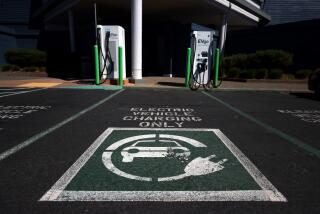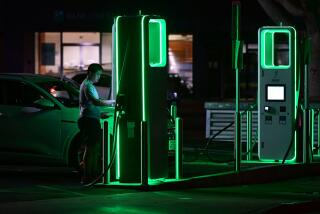Electric vehicles may bring new sticker shock: multiple mileage ratings
- Share via
According to the government, the car with the highest mileage per gallon on the market doesn’t use a single drop of gasoline.
The 2011 Nissan Leaf, which was scheduled to be delivered to its first California customers this weekend, runs entirely on battery. But the Environmental Protection Agency says it can travel 99 miles on the equivalent of a single gallon of fuel.
Confused? You’re not alone. The mileage-equivalent ratings, meant to help potential buyers compare electric cars with others in their class, are befuddling some consumers who see them as an automotive example of comparing apples and oranges.
And that’s just one of the conundrums shoppers will face when more electric vehicles begin arriving in showrooms this month.
The EPA isn’t the only entity comparing the clean-fuel cars with autos that have traditional internal combustion engines. Their ratings, which will be posted on car windows, may end up sharing space with stickers from the Federal Trade Commission and the automakers themselves.
That’s some crowded glass.
“It’s a whole new world that needs to be rated,” Nissan spokeswoman Jeannine Ginivan said. “It is for sure complicated, since there is really no gallon. For now, the consumer is going to have to decipher everything and see how to make it work for them.”
Traditionally, the fuel economy rating for vehicles with internal combustion engines is calculated from emissions generated during a series of tests.
Things got hairy with the Leaf. The EPA worked out a formula in which an electric car using 33.7 kilowatt-hours of electricity was considered equivalent to a standard vehicle using a gallon of gasoline. Because there wasn’t any physical fuel, the rating was renamed miles-per-gallon-equivalent, or mpge.
The electric vehicle will be sold with a sticker saying that it can reach up to 106 mpge in the city. The previous record-holder, the Toyota Prius hybrid, was rated at 51 mpg in urban settings.
The Leaf score is straightforward compared with the one given to the 2011 Chevrolet Volt, a hybrid plug-in that switches to gasoline when its electricity supply runs out.
The Volt doesn’t just have an overall rating. In addition to an umbrella figure of 60 mpge, the government gave it a 93-mpge rating for when the Volt is driven only in its electric mode and a 37-mpg figure for when it uses gasoline only. But few if any Volt drivers will stick to just one mode. They are more likely to use gas and electricity in varying ratios.
And not everyone agrees with the EPA’s analysis. Last year, General Motors Co. predicted that the Volt would reach 230 mpge, nearly four times the government’s overall score.
The EPA sticker for the Leaf, which also includes how far it could go on a single charge — 73 miles — may have to compete for space with a sticker from the FTC that pegs the distance at up to 110 miles. Nissan, which used a slightly different testing system, says the car can travel 100 miles on a single battery charge.
The EPA figures also include expected tailpipe emissions. Since it doesn’t need a tailpipe, the Leaf will release no carbon dioxide, according to the agency.
Some environmentalists aren’t pleased with the prognosis and suggest using what’s known as a well-to-wheel analysis instead. The process would consider all the greenhouse gases released from the time the electricity is first generated until it is sent through transmission lines to charging units.
Based on such measurements, the Leaf would rack up more than 250 grams of carbon-dioxide and other emissions every mile, according to data from the Energy Department’s Argonne National Lab. Gasoline-fueled cars on average release 450 grams a mile.
“It doesn’t matter where greenhouse gas emissions are emitted, because they’ll still affect climate change around the world,” clean-energy consultant Sandy Thomas said. “The fact that the emissions came from a coal plant producing electricity in Utah is just as bad as if they came out of the tailpipe.”
But in some parts of the country, the Volt could be responsible for more emissions than a Toyota Prius. Electricity production in California, with its strict environmental regulations and abundance of rooftop solar panels, emits a fourth of the greenhouse gases that the coal-burning power plants of the Midwest do.
Then there’s the cost. On top of the purchase prices of electric vehicles, which vary by state based on local government incentive packages, charging rates will differ by utility. The Los Angeles Department of Water and Power and Southern California Edison each offer three separate electric vehicle charging plans.
Using an average price of 11 cents per kilowatt-hour, the EPA estimates that Leaf owners will spend $561 a year on charging. Volt drivers who rely solely on the battery power will spend $601.
Take, for example, the 400-mile trek up the 5 Freeway from Los Angeles to San Francisco. The Volt can go 35 miles on the fully charged 16-kilowatt-hour battery and then an additional 344 miles on its 9.5-gallon fuel tank, bringing the total cost to about $32 with a half-gallon refuel. Doing the drive in the Leaf, with its 24-kilowatt-hour battery, would run about $14.50.
But that could all change by the time the next generation of Leafs and Volts roll around next year.
The EPA is considering an updated design for clean-fuel car labels, having recently wrapped up a 60-day public comment period that included hearings in Chicago and Los Angeles.
Options being considered include a letter grade for fuel efficiency and a proposal to create an online tool to help consumers calculate a customized emissions number for the entire electricity production and distribution cycle.







